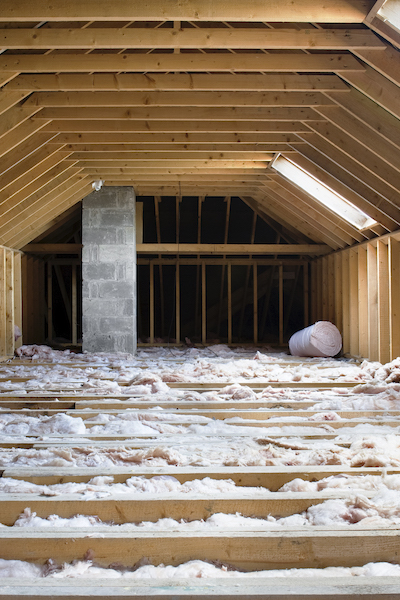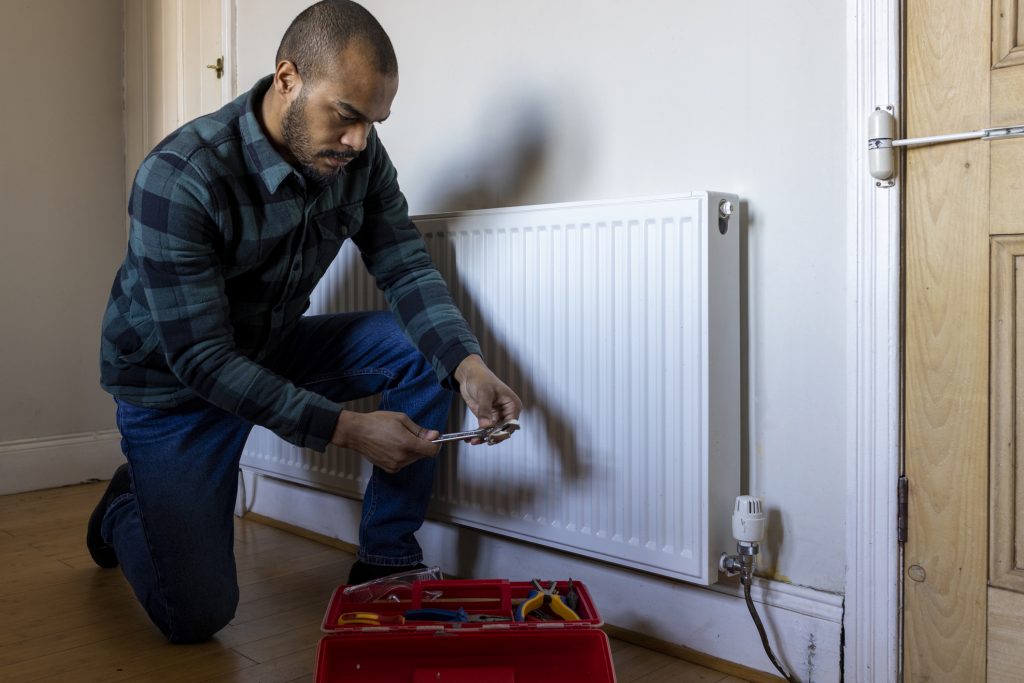Find out where your house is wasting energy so you can stop it. That’s where energy audits come in!
It’s no secret that energy costs are rising dramatically.
And that makes it even more important than ever to keep your energy waste to a minimum.
The best way to do that, by far, is with a full home energy audit.
In this article, we’ll talk you through the whole process:
- What you need to know about energy audits—a cheat sheet
- What is an energy audit
- How to get an energy audit in your neighborhood
- Energy audit costs
- How to do your own DIY energy audit
- Get a home energy assessment for free if your house qualifies
A “home energy audit” might sound intimidating (hey, anything with the word “audit” is stressful).
But, really, it’s just a fancy term for figuring out how much energy your home is using right now, what issues are causing the most energy waste in your home, and how you can best improve your home’s efficiency.
The good news here, too, is that the home energy audit process doesn’t have to be intimidating and complicated!
Basically, if you need to know anything about getting a home energy assessment, this is a great place to start.
Okay! First, for those of you who might be late for a dentist’s appointment, we’ll start with a quick overview of the basics.
What you need to know about energy audits—a cheat sheet
What is a home energy audit?
A home energy audit is a process of figuring out how much energy your home is using and how you can make changes for better efficiency. A professional, thorough audit includes an inspection of your house’s structure and insulation, as well as an overall energy efficiency assessment of your home (including lighting, HVAC, and appliances).
You can do a basic home energy audit yourself by following these steps.
What does a home energy audit include?
A professional home energy audit includes several steps:
- First, an auditor will take a look at how your home is built and how well the insulation works.
- Next, they’ll take a close look at the structure of your house to see how much energy you’re losing through drafts or leaks. (They may do a blower door test to measure how much air leakage there is in your home.) They might also use test equipment to measure how much energy is being used by your central air system, lighting fixtures, water heater, and other appliances. (1)
- Finally, the auditor will provide a list of recommendations on how to improve efficiency in your home, as well as an estimate on how much money you could save by making those changes.
If your house qualifies, get a free home energy assessment by the Home Energy Experts at Sealed. Qualify now.
Is a home energy audit worth it?
Absolutely! For most homeowners, it’s well worth the investment to have a professional energy audit done. A home energy audit can cut your energy usage in the long run by helping you identify how to make your home more efficient and reduce your monthly utility bill.
(Another benefit here: The fixes that make your home more efficient also make it way more comfortable. Say goodbye to cold floors, stuffy rooms, and drafty windows!)
How to do a basic home energy audit yourself
Here are the steps to doing your own DIY home energy audit:
- Look for air leaks in your house (get instructions for checking for air leaks here)
- Do a visual inspection of your insulation (and check to see when your house was last insulated)
- Inspect your HVAC equipment for signs of decay
- Check your energy bills for any signs of increased energy usage
- Make sure all lighting fixtures have high-efficiency bulbs
Make an inventory of your home appliances to see if any could be replaced with higher-efficiency models.
That’s the high-level list! You’ll want to tap here for full instructions on doing your own basic whole-home energy audit.
What is an energy audit (and how do you get one)?
An energy audit is the process of figuring out how much energy your home is using and how you can make changes for better efficiency.
During a professional energy audit, the auditor might perform a few tests to see where energy is escaping from or being wasted in your house:
- A blower door test is a common method that professionals use to find air leaks. During this test, a large fan is placed in an exterior door opening to depressurize the house. This causes any air leaks to become more noticeable, as they are the only sources of ventilation in the house. The blower door test can help identify how much air leakage is occurring and where it is happening.
- Thermographic scans are another way to detect air leaks in a home. This technique uses infrared cameras to capture images of the thermal energy emitted by objects. By locating areas where the thermal energy is escaping from the house, thermographic scans can help locate air leaks—and to see how much air is escaping from the home. It’s pretty neat.
Important note here: You can get an accurate energy audit without any of these tests!
Professionals can tell a lot from a visual inspection of your house, and it’s not always necessary to bring in huge pieces of equipment to see where your house is wasting energy.
But if you are planning big energy upgrades for your home, it’s likely these tests will be done before and after you complete your improvements.
Your energy auditor or home performance contractor will also take a look at how your home is built and how well the insulation works, as well as give your HVAC equipment a thorough investigation.
Heating and cooling is responsible for over half of your home’s overall energy use, so this is an important step! (2)
Finally, the auditor will want to see your energy bills, so they can identify any important usage patterns and see if there is any room for improvement.
Over 51% of your home’s energy consumption is for heating and cooling alone.
EIA.gov
After your audit, you should get a report detailing the auditor’s findings and recommendations. That way you can make informed decisions about improving energy efficiency in your home.
Then… well, it’s up to you to follow up on the recommendations and start making the upgrades.
(Unless you go with Sealed, in which case, we’ll take care of the audit, design, hiring and negotiating with contractors, and all the other difficult stuff.)

How to get an energy audit in your neighborhood
Finding an energy auditor is probably easier than you think! Here are a few places to look:
- Local utility companies will often provide audits for free (although sometimes these audits are spot checks of specific kinds of energy usage, rather than full audits).
- HVAC companies and home performance contractors can also usually do energy audits (for a fee). Be sure to check reviews and ask around to make sure it’s a company that will give you your money’s worth!
- The Department of Energy’s Home Energy Score map or Better Buildings Initiative’s Home Energy Score Partner Map are trusted national sources that can direct you to a qualified auditor in your area.
- Finally, be sure to check What home audits are available near me? (especially if you live in New York, Connecticut, New Jersey, Pennsylvania, or Illinois).
And if you’re looking for an audit that won’t cost a penny, Sealed offers a free home energy assessment that covers the same topics if your house qualifies. (More on that later.)
What does an energy audit cost?
So, just how much does an energy audit cost? On average, professional home energy audits cost between $208–$670 (3).
But that’s far from the whole story—especially if you’re interested in how to get a free or low-cost energy audit.
There are plenty of ways to make an energy audit easier on the budget. For example, the Inflation Reduction Act—which was signed into law in 2022—can cover up to $150 of your energy audit cost (4). (Be sure to keep that receipt.)
Learn more about what new home energy rebates are available under the Inflation Reduction Act.
Sealed (hello—that’s us!) offers a home energy assessment that covers similar topics as any other professional home energy audit.
We’ll analyze (and show you!) where your house is likely wasting energy through air leaks, insufficient insulation, or underperforming HVAC systems and make recommendations to fix the issues for good.
The big difference? If your house qualifies to work with Sealed, you’ll get a free energy assessment.
Plus, you don’t have to get out of your pajamas to get one. Your expert assessment is done remotely! (See if you’re eligible in 2 minutes.)
How to do your own DIY energy audit
Not quite ready to call in a professional?
You can learn a lot by performing your own assessment. Here’s how to do an energy audit:
- Examine your house’s insulation
- Look for air leaks in your home
- Inspect your heating and cooling equipment
- Review the last 24 months of your energy bills
- Check your light fixtures
- Inspect your home appliances

Take a close look at your insulation
Hey, you say, I already know my home is insulated!
We believe you! But here’s the thing with insulation: Like the rest of us, it gets old.
And when it does, its effectiveness diminishes to the point that it may no longer form an effective barrier to keep inside air in.
Another thing to note with insulation is that there’s a good chance the original builders of your house didn’t use enough of it—or that they didn’t insulate every area that needed to be insulated.
Energy-efficiency standards weren’t really a part of U.S building requirements until the new millennium, so if your house was built before or in the early 2000s, there’s a good chance it’s under-insulated.
So when you do a home energy audit, insulation is one of the primary things to look at. First, check your home’s records to see when the insulation was last updated. This can help you determine whether your insulation is due for a replacement.
(If your insulation hasn’t been updated in 30 years, that’s a good sign you’re due for an upgrade. But some types of insulation start degrading around year 10.)
Then, it’s time to take a good look at the insulation you already have.
More specifically? You’ll want to check the insulation in the attic, because that’s one of the most important parts of home insulation to get exactly right—when your attic insulation is failing, it’s a big contributor to energy waste.
Discover the science behind insulation upgrades. Read How does insulation save energy? to learn more.
90% of US homes are under-insulated.
NAIMA
If you can see crumbling, worn out insulation, the joists sticking up over your insulation in the attic, or a lack of wall insulation (by a quick peek into your walls by removing outlet covers), it’s time for a fix.
Look for air leaks in your house
Here’s a fact you should brace yourself for: Air leaks (that is, the tiny holes around your foundation, windows, doors, etc.) are responsible for up to 40% of the energy use in your home (5). Yikes.
Air leaks are also a big reason for the drafts around your windows.
(Read How to fix a drafty house for more information about all of this.)
How do you find these air gaps? First, you should definitely read this full guide to locating the air leaks in your home.
But, for now, know that common areas for air leaks include places like:
- Cracks around windows and doors
- Gaps around electrical outlets and lighting
- Holes and seams for plumbing or wiring
Once you have located the source of the leaks, you’ll want to seal them—every last one of them!—using caulk, weather-stripping, or other materials.
By the way, air sealing is a big project, and we recommend calling in professionals to do it. For more information on all of this in the meantime, be sure to check out our guide to home weatherization.

Inspect your heating and cooling equipment
Time to look at your HVAC system!
Many people overlook this aspect of their energy audit, but it is essential for maintaining a comfortable home and reducing energy costs.
Check to see that all the maintenance records are up to date, and make sure your equipment has had its scheduled service.
Make sure that all components of your HVAC system are in good condition and that any filters are clean.
Next, take a look at the equipment itself for…anything odd really. Pay attention to mold, leaks, air conditioner or furnace smells, signs of damage, like rust. (If something doesn’t look right… it probably isn’t.)
If you notice any signs of wear it’s important to address them quickly to ensure that the system continues to operate efficiently.
Finally, if you have a ducted air system, grab your flashlight and take a look at your ductwork.
Obviously, you won’t catch everything since you’re not a professional, but look for obvious cracks and seams, that kind of thing.
20–30% of the air that moves through the duct system is lost due to leaks, holes, and poorly connected ducts.
Energystar.gov
Open gaps in your ductwork = energy waste through duct leaks.
(By the way, if you’re tired of taking care of a complex, aging HVAC system, the best way to make your life easier is with an all-in-one heat pump. Which you can get for $0 upfront, if you qualify.)
Look at your last 24 months of heating and cooling bills
Your utility bills are the best way to keep track of how much energy you use. By looking at how usage patterns change over time, you can get an idea of any patterns—or anomalies.
For example, if you notice any unusual spikes in your energy bills—or a sudden increase in energy usage that never resolved—that’s a big indicator that something is going wrong.
Check all your lighting fixtures
We’ll be honest here: When it comes to energy waste, your lighting is probably the least of your worries.
(Making sure your house is properly insulated as well as fixing inefficient HVAC will do so much more to curb your energy waste.)
That said, every little improvement counts, and the lighting fixtures in your home do have an impact on how much energy you use.
So you probably already know the drill here:
- Take a look at the type and number of lights you have in each room.
- Replace any halogen bulbs with more energy-efficient options such as LED bulb.
Simple, right? (If you have your calculator handy and want to get intense about it, here are full instructions for a DIY lighting audit.)
Inspect your home appliances
Finally, be sure to check how well your home appliances are running. Look for any signs of wear and tear or poor performance.
If you find any issues, consider investing in a more efficient model or having the appliance serviced by a professional.
(But keep in mind, too, that if you’re working with a limited budget, it’s far more important to make sure your house is properly sealed and insulated. Much bigger bang for the buck!)
Get a professional home energy assessment for free
Okay! That’s the DIY energy assessment!
Keep in mind: This process can be great to get a baseline idea of how efficient your house is—but it has limits.
And if you’re having major comfort issues, trust us: There’s really no substitute for calling in a professional, especially when you can get a professional energy audit for free.
Okay, try this on for size: What if you could get a professional home energy assessment started right now?
With Sealed, you can. (If your house qualifies, of course.)
Here’s how it works: If your house is eligible for Sealed—you can find out in a few minutes—you’ll answer a few easy questions about your comfort levels and the issues you’ve been experiencing in your house. We’ll also direct you to take some pictures of some key areas of your house.
Then the fun part! Our team of experts will take a close look at all the information and get back to you with an expert energy assessment that tackles the most energy-wasting parts of your home: air leaks, insulation issues, and underperforming HVAC.
We’ll let you know where your house is wasting the most energy and tell you which upgrades will make the biggest difference in your energy usage. (And—huge bonus!—these same energy-saving upgrades also make your house feel amazing year round).
Then if you choose to get upgrades through us (no obligation!), you’ll pay for the work done with a flexible payment option that works best for you and your budget..
Interested?
See if your house qualifies in 2 minutes.
As an architect and a homeowner, I can say that Sealed’s energy-saving expertise is really invaluable.
Lisa – Westchester, NY, Sealed customer
For further reading, check out the following for a deeper dive into your energy bills:
- Why is my heating bill so high?
- Rising electricity costs: Why are electricity prices going up?
- Propane home heating: Why is propane so expensive?
- Natural gas prices: Why is natural gas going up?
- Heating oil costs: Why is home heating oil so expensive?
The above guides are great resources to help you understand why your energy bills could be spiking right now—and what to do about it.